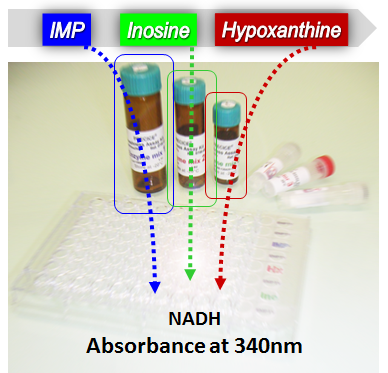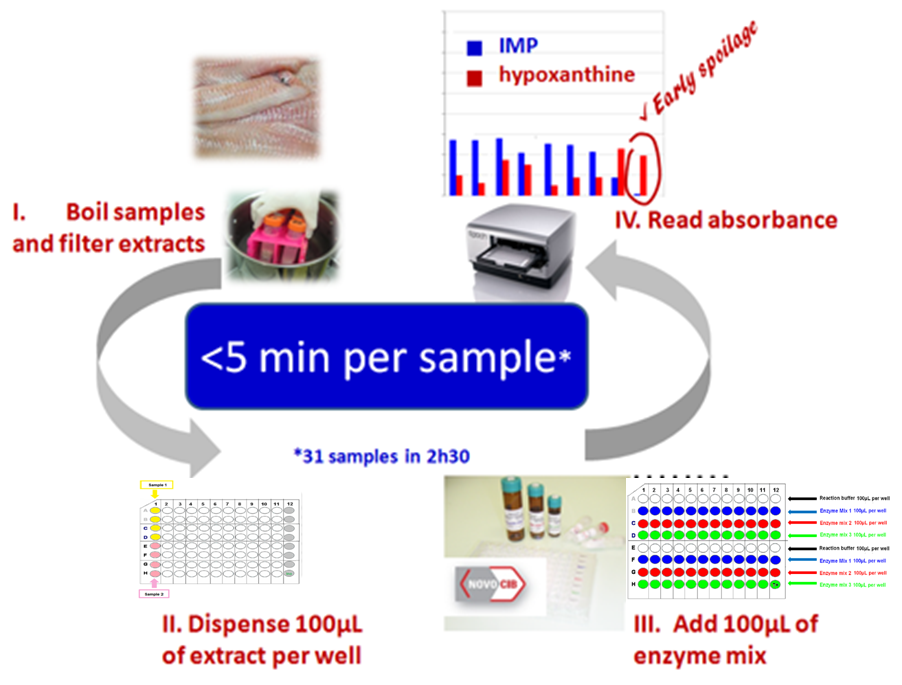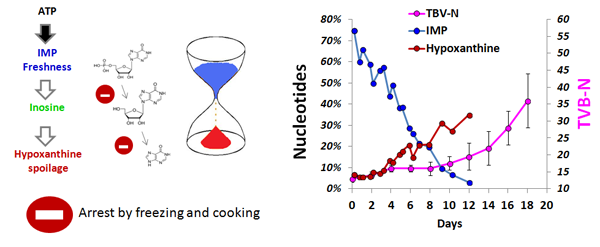

Since seafood and fish are highly perishable products, the quality of raw material is of primary concern for seafood processing industry. Testing raw material is first main stage of currently used procedure of Quality Control.
While sensory analysis allows rapid evaluation of the quality of whole wet fish, the assessment of the quality of frozen fish, or that of frozen blocks of fillets or crumbed seafood products remains more difficult.
PRECICE® Freshness Assay Kit is a first microplate assay for routine physico-chemical assessment of quality of seafood freshness. The enzymes provided with kit allow specific conversion of three major ATP catabolites - IMP, inosine (Ino) and hypoxanthine (Hx) to NADH2. The quantification of nucleotides is done by measuring sample absorbance at 340nm. Used enzymatic reactions are: highly specific and selective toward each particular nucleotides; fast and irreversible; brings three nucleotides to one common denominator (NADH2).


| #REF | Kit Version | SIZE | PRICE | |
|---|---|---|---|---|
| #K0700-001-15 | PRECICE® K(IMP) | 15 Kits | € 250.00 | Inquiry |
| #K0700-001-31 | PRECICE® K(IMP) | 31 Kits | € 370.00 | Inquiry |
| #K0700-001-31 | PRECICE® (IMP, Ino & Hx) | 22 Kits | € 370.00 | Inquiry |
Kit is provided in stable lyophilized form and shipped without dry ice
You can ask us for a quotation here or write at contact@novocib.com
Download PRECICE® K (IMP) Assay Kit (User manual)
Download PRECICE® Freshness (IMP, Ino, Hx) Assay Kit (User manual)
The content of ATP is particularly high in muscle where ATP is used for contraction. As soon as an animal dies, cell respiration stops as well as ATP formation. Post-mortem ATP degradation leads to rapid formation of IMP (5-24h), Inosine (days) and Hypoxanthine (weeks). The formation of IMP and inosine is mainly due to autolytic reactions, whereas hypoxanthine is a result of both autolytic and microbial degradation. The utilisation of nucleotides as freshness indicators were first suggested by pioneer works of Japanese scientists in the late 1950's (Saito et al.1958) and was further confirmed by numerous scentific articles. In difference to TVB-N or TMA widely used to detect biochemical changes that appear at a medium- or a late-stage of spoilage, nucleotides provide the tools to detect very beginning of spoilage process(Scheme 1).
